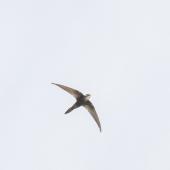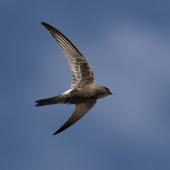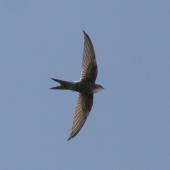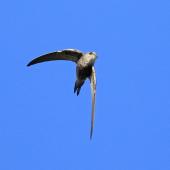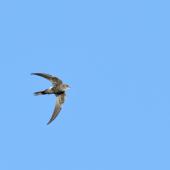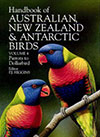Fork-tailed swift
Apus pacificus (Latham, 1802)
Order: Apodiformes
Family: Apodidae
Other names: Pacific swift, large white-rumped swift, forktailed swift, fork tailed swift
Geographical variation: Four races recognised: pacificus, kanoi, leucomyx and cooki; pacificus strays to New Zealand
Swifts are fast flying birds that spend most of the year on the wing, only landing during the breeding season. Their legs are so short and their wings so long that they are unable to take off if they are placed on the ground. They have wide mouths that are used to feed on ‘aerial plankton’.
Identification
The fork-tailed swift is a ‘typical’ swift with scimitar shaped wings and mostly blackish plumage. The rump is white and the throat and upper breast pale grey; the tail is deeply forked.
Voice: A shrill scream uttered in flight.
Similar species: white-throated needletail has a conspicuous white throat, white horseshoe mark under tail and a blunt looking tail. Welcome swallow has a deeply forked tail but glossy blue-black upper parts, red face and pale greyish underparts. Fairy martin and tree martins have pale underparts and almost square tails.
Distribution and habitat
Fork-tailed swifts breed across much of east and South-east Asia, and are widespread in Australia in the non-breeding season. They spend most of the year relatively high in the air column, only coming down to near ground level at times of bad weather.
Population
Fork-tailed swifts have been recorded from both main islands, as well as Antipodes and Campbell Islands, with about 20 records in total (a maximum of 4 birds at one time). A. p. pacificus, which is the northernmost population breeding in Japan and northern China, is the race that spends the non-breeding season in New Guinea and Australia and strays to New Zealand. There are no estimates of population size, but flocks of up to 50-90,000 have been recorded in Australia.
Threats and conservation
None known, however it is likely that populations of prey species have been and are being affected by pesticide use and air pollution, which remain serious problems in much of east Asia, as well as global climate change.
Breeding
Fork-tailed swifts nest in colonies on cliffs. A clutch of 2-3 eggs is laid in a nest of grass and other vegetation glued together with saliva.
Behaviour and ecology
In New Zealand apparently entirely aerial, usually seen flying over open country.
Food
Insectivorous, probably taking a wide range of species including spiders carried aloft as ‘aerial plankton’.
Weblinks
References
Chantler, P.; Driessens, G. 1995. Swifts - a guide to the swifts and treeswifts of the world. Pica Press, Sussex. 237 p.
del Hoyo, J.; Elliott, A.; Sargatal, J. (eds.). 1999. Handbook of birds of the world. Vol. 5. Barn-owls to hummingbirds. Lynx Edicions: Barcelona. Pp. 759.
Department of Sustainability, Environment, Water, Population and Communities (2012). Apus pacificus in Species Profile and Threats Database, Department of Sustainability, Environment, Water, Population and Communities, Canberra. Accessed 18 May 2022.
Heather, B.; Robertson, H. 1996. The field guide to the birds of New Zealand. Viking: Auckland. Pp. 432.
Higgins, P.J. (ed.). 1999. Handbook of Australian, New Zealand and Antarctic birds. Vol. 4. Parrots to Dollarbird. Oxford University Press, Melbourne. Pp. 1248.
Nocera, J.J.; Blais, J.M.; Beresford, D.V.; Finity, L.K.; Grooms, C.; Kimpe, L.E.; Kysrer, K.; Michelutti, N.; Reudink, M.; Smol, J.P. 2012. Historical pesticide applications coincided with an altered diet of aerially foraging insectivorous chimney swifts. Proceeding of the Royal Society B 279: 3114-3120.
Recommended citation
Melville, D.S. 2013. Fork-tailed swift. In Miskelly, C.M. (ed.) New Zealand Birds Online. www.nzbirdsonline.org.nz
Fork-tailed swift
- Breeding season
-
- Jul
- Aug
- Sep
- Oct
- Nov
- Dec
- Jan
- Feb
- Mar
- Apr
- May
- Jun
- Egg laying dates
-
- Jul
- Aug
- Sep
- Oct
- Nov
- Dec
- Jan
- Feb
- Mar
- Apr
- May
- Jun
Fork-tailed swift
- Breeding season
-
- Jul
- Aug
- Sep
- Oct
- Nov
- Dec
- Jan
- Feb
- Mar
- Apr
- May
- Jun
- Egg laying dates
-
- Jul
- Aug
- Sep
- Oct
- Nov
- Dec
- Jan
- Feb
- Mar
- Apr
- May
- Jun





